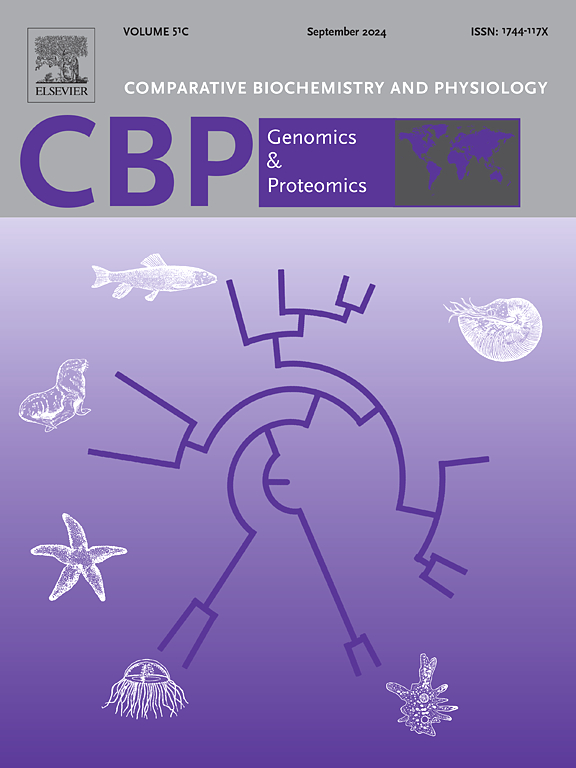叶氏Patinopecten yessoensis三个主要神经节的转录组特征为双侧中枢神经系统的单系起源提供了新的见解
IF 2.2
2区 生物学
Q4 BIOCHEMISTRY & MOLECULAR BIOLOGY
Comparative Biochemistry and Physiology D-Genomics & Proteomics
Pub Date : 2025-07-18
DOI:10.1016/j.cbd.2025.101585
引用次数: 0
摘要
关于双侧动物的中枢神经系统(CNS)是独立产生的还是单系起源的问题一直争论不休。越来越多的证据支持中枢神经系统的单系起源跨越三个主要的双侧群体。然而,在第二大动物门软体动物中,中枢神经系统的进化信息主要来自于头足类动物,其中有神经节的头神经系统与脊椎动物脑的同源性存在争议。Yesso扇贝(Patinopecten yessoensis)是一种双壳类软体动物,以其缓慢进化的基因组和不同保存的神经节融合痕迹而脱颖而出。在此,我们系统地分析了叶索扇贝三个主要神经节的转录组。我们利用基因共表达网络确定了神经节相关模块,并发现了神经递质受体和下丘脑激素受体的扩展,表明扇贝的中枢神经系统比我们想象的要复杂。我们的分析显示在神经节中主要表达扩大的下丘脑激素受体。此外,脊椎动物垂体发育的基本标记在扇贝神经节中很大程度上是保守的,这表明垂体具有共同的进化起源。我们对特定神经节特征的研究表明,神经节融合促进了结构和功能的复杂性。特别是,基因集富集分析(GSEA)表明,脊椎动物垂体或脑发育的基因集被扇贝神经节中表达的基因富集,表明神经节神经系统与脊椎动物脑具有同源性,支持脑的单系起源。我们的发现为了解双侧动物脑和垂体的单系起源提供了新的证据。本文章由计算机程序翻译,如有差异,请以英文原文为准。

Transcriptome characterization of three main ganglia in Patinopecten yessoensis provides novel insights into a monophyletic origin of the bilaterian central nervous system
The question of whether the central nervous system (CNS) of bilaterians arose independently or has a monophyletic origin has been hotly debated. Increasing evidence supports the monophyletic origin of CNS across the three major bilaterian groups. However, in Mollusca, the second largest animal phylum, evolutional information of CNS was mainly obtained from cephalopods, of which the ganglionated cephalic neural system is under controversy to be homolog to vertebrate brain. Yesso scallop (Patinopecten yessoensis), a bivalve mollusk stands out with its slow-evolving genome and differential preservation of ganglia fusion trace. Here, we systematically analyzed the transcriptome of three main ganglia in Yesso scallop. We identified a ganglia-related module using gene co-expression network, and discovered the expansion of neurotransmitter receptors and hypothalamic hormone receptors, suggesting a complex CNS in scallops than we thought. Our analysis revealed predominant expression of expanded hypothalamic hormone receptors in ganglia. Furthermore, the repertoire of fundamental markers for vertebrate pituitary development was largely conserved in scallop ganglia, suggesting a shared evolutionary origin of the pituitary. Our investigation of specific ganglia characteristics demonstrated that ganglia fusion promotes both structural and functional complexity. Particularly, gene-set enrichment analysis (GSEA) demonstrated that gene sets of vertebrate pituitary or brain development are enriched by genes expressed in scallop ganglia, indicating the homolog between ganglionated neural system and vertebrate brain, which supporting the monophyletic origin of brain. Our findings provide new evidences to understand the monophyletic origin of the brain and pituitary in bilaterians.
求助全文
通过发布文献求助,成功后即可免费获取论文全文。
去求助
来源期刊
CiteScore
5.10
自引率
3.30%
发文量
69
审稿时长
33 days
期刊介绍:
Comparative Biochemistry & Physiology (CBP) publishes papers in comparative, environmental and evolutionary physiology.
Part D: Genomics and Proteomics (CBPD), focuses on “omics” approaches to physiology, including comparative and functional genomics, metagenomics, transcriptomics, proteomics, metabolomics, and lipidomics. Most studies employ “omics” and/or system biology to test specific hypotheses about molecular and biochemical mechanisms underlying physiological responses to the environment. We encourage papers that address fundamental questions in comparative physiology and biochemistry rather than studies with a focus that is purely technical, methodological or descriptive in nature.

 求助内容:
求助内容: 应助结果提醒方式:
应助结果提醒方式:


